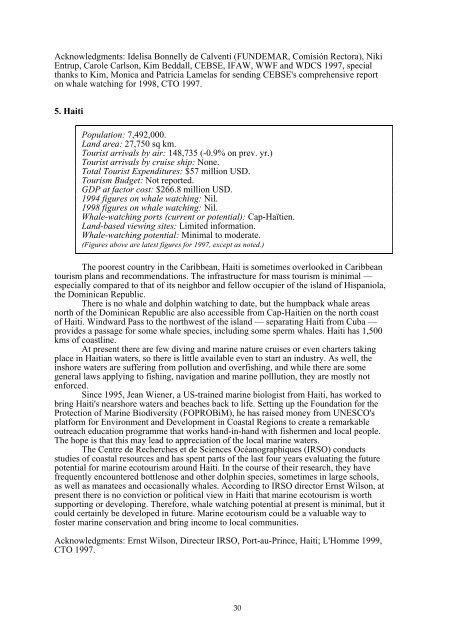The Potential of Whale Watching in the Caribbean: 1999+
The Potential of Whale Watching in the Caribbean: 1999+
The Potential of Whale Watching in the Caribbean: 1999+
You also want an ePaper? Increase the reach of your titles
YUMPU automatically turns print PDFs into web optimized ePapers that Google loves.
Acknowledgments: Idelisa Bonnelly de Calventi (FUNDEMAR, Comisión Rectora), Niki<br />
Entrup, Carole Carlson, Kim Beddall, CEBSE, IFAW, WWF and WDCS 1997, special<br />
thanks to Kim, Monica and Patricia Lamelas for send<strong>in</strong>g CEBSE's comprehensive report<br />
on whale watch<strong>in</strong>g for 1998, CTO 1997.<br />
5. Haiti<br />
Population: 7,492,000.<br />
Land area: 27,750 sq km.<br />
Tourist arrivals by air: 148,735 (-0.9% on prev. yr.)<br />
Tourist arrivals by cruise ship: None.<br />
Total Tourist Expenditures: $57 million USD.<br />
Tourism Budget: Not reported.<br />
GDP at factor cost: $266.8 million USD.<br />
1994 figures on whale watch<strong>in</strong>g: Nil.<br />
1998 figures on whale watch<strong>in</strong>g: Nil.<br />
<strong>Whale</strong>-watch<strong>in</strong>g ports (current or potential): Cap-Haïtien.<br />
Land-based view<strong>in</strong>g sites: Limited <strong>in</strong>formation.<br />
<strong>Whale</strong>-watch<strong>in</strong>g potential: M<strong>in</strong>imal to moderate.<br />
(Figures above are latest figures for 1997, except as noted.)<br />
<strong>The</strong> poorest country <strong>in</strong> <strong>the</strong> <strong>Caribbean</strong>, Haiti is sometimes overlooked <strong>in</strong> <strong>Caribbean</strong><br />
tourism plans and recommendations. <strong>The</strong> <strong>in</strong>frastructure for mass tourism is m<strong>in</strong>imal —<br />
especially compared to that <strong>of</strong> its neighbor and fellow occupier <strong>of</strong> <strong>the</strong> island <strong>of</strong> Hispaniola,<br />
<strong>the</strong> Dom<strong>in</strong>ican Republic.<br />
<strong>The</strong>re is no whale and dolph<strong>in</strong> watch<strong>in</strong>g to date, but <strong>the</strong> humpback whale areas<br />
north <strong>of</strong> <strong>the</strong> Dom<strong>in</strong>ican Republic are also accessible from Cap-Haitien on <strong>the</strong> north coast<br />
<strong>of</strong> Haiti. W<strong>in</strong>dward Pass to <strong>the</strong> northwest <strong>of</strong> <strong>the</strong> island — separat<strong>in</strong>g Haiti from Cuba —<br />
provides a passage for some whale species, <strong>in</strong>clud<strong>in</strong>g some sperm whales. Haiti has 1,500<br />
kms <strong>of</strong> coastl<strong>in</strong>e.<br />
At present <strong>the</strong>re are few div<strong>in</strong>g and mar<strong>in</strong>e nature cruises or even charters tak<strong>in</strong>g<br />
place <strong>in</strong> Haitian waters, so <strong>the</strong>re is little available even to start an <strong>in</strong>dustry. As well, <strong>the</strong><br />
<strong>in</strong>shore waters are suffer<strong>in</strong>g from pollution and overfish<strong>in</strong>g, and while <strong>the</strong>re are some<br />
general laws apply<strong>in</strong>g to fish<strong>in</strong>g, navigation and mar<strong>in</strong>e polllution, <strong>the</strong>y are mostly not<br />
enforced.<br />
S<strong>in</strong>ce 1995, Jean Wiener, a US-tra<strong>in</strong>ed mar<strong>in</strong>e biologist from Haiti, has worked to<br />
br<strong>in</strong>g Haiti's nearshore waters and beaches back to life. Sett<strong>in</strong>g up <strong>the</strong> Foundation for <strong>the</strong><br />
Protection <strong>of</strong> Mar<strong>in</strong>e Biodiversity (FOPROBiM), he has raised money from UNESCO's<br />
platform for Environment and Development <strong>in</strong> Coastal Regions to create a remarkable<br />
outreach education programme that works hand-<strong>in</strong>-hand with fishermen and local people.<br />
<strong>The</strong> hope is that this may lead to appreciation <strong>of</strong> <strong>the</strong> local mar<strong>in</strong>e waters.<br />
<strong>The</strong> Centre de Recherches et de Sciences Océanographiques (IRSO) conducts<br />
studies <strong>of</strong> coastal resources and has spent parts <strong>of</strong> <strong>the</strong> last four years evaluat<strong>in</strong>g <strong>the</strong> future<br />
potential for mar<strong>in</strong>e ecotourism around Haiti. In <strong>the</strong> course <strong>of</strong> <strong>the</strong>ir research, <strong>the</strong>y have<br />
frequently encountered bottlenose and o<strong>the</strong>r dolph<strong>in</strong> species, sometimes <strong>in</strong> large schools,<br />
as well as manatees and occasionally whales. Accord<strong>in</strong>g to IRSO director Ernst Wilson, at<br />
present <strong>the</strong>re is no conviction or political view <strong>in</strong> Haiti that mar<strong>in</strong>e ecotourism is worth<br />
support<strong>in</strong>g or develop<strong>in</strong>g. <strong>The</strong>refore, whale watch<strong>in</strong>g potential at present is m<strong>in</strong>imal, but it<br />
could certa<strong>in</strong>ly be developed <strong>in</strong> future. Mar<strong>in</strong>e ecotourism could be a valuable way to<br />
foster mar<strong>in</strong>e conservation and br<strong>in</strong>g <strong>in</strong>come to local communities.<br />
Acknowledgments: Ernst Wilson, Directeur IRSO, Port-au-Pr<strong>in</strong>ce, Haiti; L'Homme 1999,<br />
CTO 1997.<br />
30
















